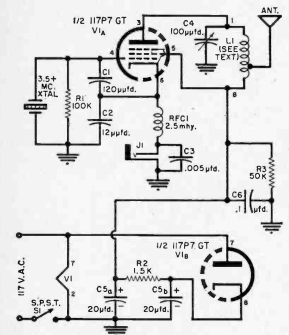 Sixty years ago this month, the May 1958 issue of Popular Science showed how to make this compact one-tube transmitter for local or standby use. The set used a 117P7 or 117L7 tube, which combined a rectifier and pentode, to put out about six watts on 80 or 40. Band choice was accomplished with plug-in coils, and the rig ran directly off AC power.
Sixty years ago this month, the May 1958 issue of Popular Science showed how to make this compact one-tube transmitter for local or standby use. The set used a 117P7 or 117L7 tube, which combined a rectifier and pentode, to put out about six watts on 80 or 40. Band choice was accomplished with plug-in coils, and the rig ran directly off AC power.
Since the Altoid tin had apparently not been invented, a card file box was used for the enclosure.


Using an Altoid Tin would have outright killed you, if you put the plug in upside down. This is an AC-DC transmitter, there´s no separation between mass and live line-voltage. Today something like this would be at minimum heavily criticized, if not outright forbidden to publish. In the 50s safety standards weren´t that developed yet, or rather common sense prevailed. Except for my Hallicrafters 50s SW receiver, I´ve never seen an AC-DC radio receiver/transmitter in a metal (conductive) enclosure, regardless of how well it shields. In case my Hallicrafters I gotta use a separation transformer to avoid being electrocuted by accident.
So there you have the ´why´ around the Altoids Tin: They didn´t want hundreds of roasted kid Hams laying around, let alone be responsible for it!
Regards,
ON4SPK
Well, yes. You don’t want to use this one in the bathtub! I guess the box they used was wood, which is better, but one side of the key, and one side of the variable capacitor have a 50/50 chance of being hot!